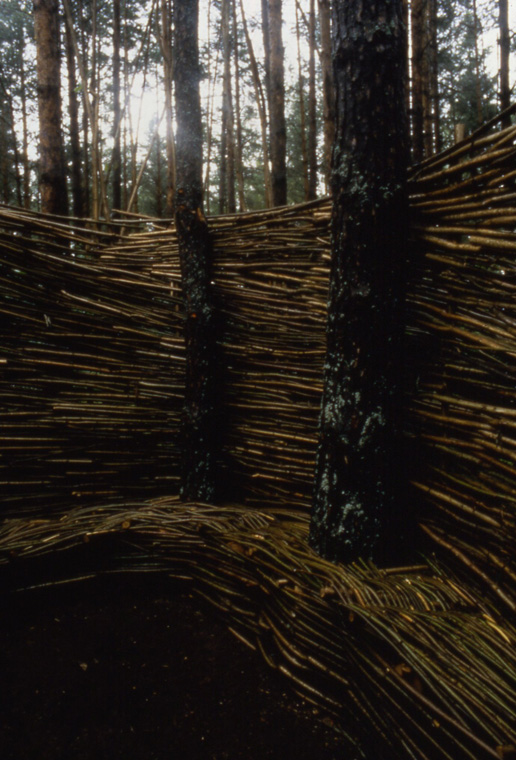Space for Contemplating Lithuania...All the While the Snails Crawled
Europos Parkus, Vilnus, Lithuania, 1998, Hazelnut saplings, rammed earth with straw and flax, moss, 20 x 25 x 7.5' at highest point (6.1m x 7.6m x 2.3m).
The form of the sculpture was inspired by the shells of land snails that have lived in Lithuania for eons. These snails have crawled across forest floors through invasions, wars, border shifts, occupations, secret pacts, deportations, resistance and independence. Attempting to understand the historical, cultural and political situation in Lithuania through the voices of its own people was extraordinary. It was painful, and extremely complex; almost to the point of being overwhelming. I felt the need for a space in which to contemplate this and so understood that others might have a similar need.
It was my desire for this work to rise up, almost organically, from the place. It is made from the trees, earth, mosses and crops that grow in and near the park. The spiral structure was built up through the process of weaving hazelnut saplings into gradually ascending double walls. The incremental process of weaving may be likened to the process of accretion through which the snails create their shells. Weaving saplings in this manner is a common mode of construction all over Lithuania, particularly as garden fences in rural areas, though I have seen it used as erosion baffles on the Baltic coast and in cities, around outdoor eating areas at cafes.
The sandy soil found at the site was mixed with clay, straw and flax and then rammed into place between the lower woven walls. This forms an encircling earthen ramp around the exterior perimeter as fortification for the space. The mossy forest floor has been lifted up and placed onto this ramp, making it a part of the sculpture. The double woven walls of the spiral space become visually more complex, signaling the complexity of deep thought, as they separate in height just before the spiral turns inward. The tall interior walls enclose a circular space and frame a view through the trees to the sky. The interior is fitted with low woven benches that provide a resting place for the body. The mind is released for contemplation.
The sculpture is woven in and around tall pines that form a small clearing just below the crest of a hill. To enter the spiral one walks in a counter clockwise direction, as though leaving time. A microcosm is created in the interior space--one that is physically constructed for looking inward and upward, or for dialog between a few people. Upon leaving the enclosed interior space, the walls slope downward and there is a view into the surrounding woods. One walks in a clockwise direction when leaving the space to rejoin the world's time.





